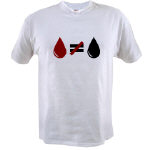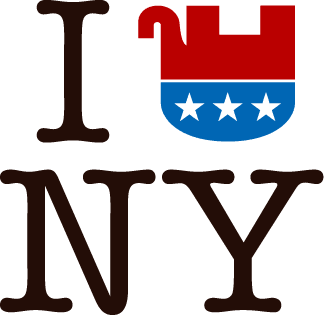posters
Fashion Statement
OK, OK, OK.
So, every time I show someone a graphic idea for a flyer or something they inevitably say, “You know, that would make a great T-shirt.”
Alright, then. I’ve created a few at CafePress. You can order them online at http://cafeshops.com/nornc
For sale: T-shirts, tank tops, posters, postcards, and stickers to welcome the Republicans in style.
Only three designs so far, but let me know what you think and I might make more.
Note, all prices shown are CafePress’s base prices. I’m not making any money here. I just want to get the word out.
---
And by the way, if you want to design some T-shirts yourself, CafePress makes it fairly easy. Basically, you upload a high resolution graphic through your Web browser to their Web site, select the product, and order it online. Voila! They handle the payment processing, printing, shipping, and customer service. You can put your design onto T-shirts, hoodies, lunch boxes, frisbees, postcards, and more. (See for instance, this lovely turntable mousepad I made.) Setting up a basic store online is free.
Preaching to the Converted
One often hears the criticism that political graphics are just “preaching to the converted.” After all, no one’s mind is changed by a poster. Why waste limited time and energy on mutual admiration? A self-reinforcing love-in doesn’t move the masses.
This criticism assumes that such graphics are actually intending to change the mind of the viewer. In turn, this is based on a narrow conception of how advertising works: one sells an idea, brand, or product to a passive and otherwise uninterested consumer.
Whatever the intention, the function of posters is often not to change people’s minds outright, but to push them in a certain direction. Posters make ideas publicly visible and provide alternative explanations, interpretations, narratives, and myths, or reinforce existing ones. Whether or not they directly convince, posters can provoke skepticism. And, without putting forth a nuanced argument, posters can provide notice of an event or opportunity.
Within politically marginalized communities, posters are a way for the community to assert its voice publicly, to put forward its own images and narratives, promote collective action, and ultimately seize political power and push for social change. When no dissent is visible in the corporate media, posters and graphics are one alternative venue. Showing cracks in the ‘consensus’ may convince others to speak out.
While many in the street are ephemeral and quickly replaced or washed away, posters also have historical value. They are often collected and preserved by a variety of individuals and institutions. As Carol Wells, of the Center for the Study of Political Graphics, points out, when history is written by the victors, posters provide a tangible record of social movements otherwise confined to the margins or entirely left out of the ‘acceptable’ narrative. Such grahpics are a visible voice from the past that future generations can learn from and build upon.
But if graphics don’t change people’s minds, how does one reach those ‘moderates,’ ‘undecideds,’ and ‘swing states’? drapetomaniac once proposed that changing minds is often an indirect result of propaganda. No one I know listens to right-wing talk radio, yet somehow its arguments seep into the “mainstream,” occasionally tilting “conventional wisdom,” and ultimately trickling into casual conversation. I imagine that hearing an idea one agrees or learning additional facts, broadcast with conviction from a source you trust may do something to bolster one’s own confidence. And in conversations with others, this must surely come across.
While those 92% of people polled who said political ads had not swayed them to change their prospective votes, how would a poll measure the impact of the ads on the people who agreed with the messages? i.e. of those people on others?
So why not preach to the converted? There’s certainly a value in bringing people together around an issue, rallying the base, and reinvigorating exhausted campaigners.
Was that March?
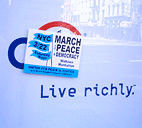
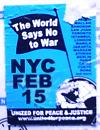
On a couple of occasions I’ve noted my admiriation for the design used by United for Peace and Justice to publicize anti-war events in New York City. The simple flag and globe motif on a bright blue ground and its bold sans-serif type are eye-catching, clear, and instantly recognizable.
However, the consistency and repetition of such a strong image in the same context (via stickers and flyers) over nearly three years may be diminishing its impact. As one UPfJ organizer notes:
“We love the blue flag standard, but have heard feedback that the design has been the same for too long... folks think it’s for an old demo.”
Dear Mr. Reagan,

See also Graphics for the Gipper, an online exhibition from the Center for the Study of Political Graphics showing more than 45 posters criticizing Ronald Reagan over two decades.
Contesting Power
In recent months, there have been several open calls to designers to help stir up the electorate.
Designs On The White House
![]() “Designs On The White House is a grassroots fund-raising organization in support of the John Kerry 2004 Presidential campaign. We aim to mobilize the creative community through an online design contest, judged by designers, celebrities, and activists. Winning designs will be available for resale on T-shirts and other products, and all proceeds after expenses will benefit the John Kerry Presidential campaign. Designs on the White House Organization (DOTWHO) is an independent political committee and is not authorized by any candidate or candidate’s committee.
“Designs On The White House is a grassroots fund-raising organization in support of the John Kerry 2004 Presidential campaign. We aim to mobilize the creative community through an online design contest, judged by designers, celebrities, and activists. Winning designs will be available for resale on T-shirts and other products, and all proceeds after expenses will benefit the John Kerry Presidential campaign. Designs on the White House Organization (DOTWHO) is an independent political committee and is not authorized by any candidate or candidate’s committee.
The Categories
- Best Pro-Kerry Shirt (positive spin, no mention of Bush)
- Best Anti-Bush Shirt (negative spin, must mention Bush)
- Best Issue Shirt - Domestic
- Best Issue Shirt - Foreign
- Funniest Shirt
- Best Retro Shirt
- Best Get Out The Vote Shirt
- Most stylish / Most likely to be featured on Queer Eye
Each design will be entered in only one category.”
Anyone with a valid email address can register with the site and cast their votes on the contributed designs.
The site also features blogs about the DOTWH campaign and the Kerry campaign. A recent entry encourages non-designers with design or slogan ideas to post them.
The deadline for entries is May 22, 2004.
Let Down By Labour
![]() “Want to see your film on national television? Want your poster idea on High Street billboards? Want to tell everyone how labour have let you down? We can make it happen for you.
“Want to see your film on national television? Want your poster idea on High Street billboards? Want to tell everyone how labour have let you down? We can make it happen for you.
‘Labour isn’t Working’ fast became one of the most famous posters in advertising history. Imagine if you had been able to have a crack at that brief? Just as in 1979 when Labour wasn’t working, today swathes of the population feel let down by Labour.”
The final date for submissions was April 23, 2004.
“We have received a massive response from the people of Great Britain and we would like to thank all of you for your contributions. We will be displaying the best ideas in a gallery so that everyone can see how let down by Labour the British people feel. The large number of submissions we have received means that it will take some time for us to sort through the ideas. But as soon as they are ready to be unveiled to the public we will be presenting a selection of them here. Once again thank you for your support.”
And from the comments of VoxPop:
One thing CCO isn’t shouting from the rooftops is that they opened this competition to the "creative industries" (i.e. trendy spec-wearing ripped jeans fans) the week before they opened it to the public.
Also, there’s absolutely no guarantee that they’ll use any of the entries.
Honestly, this scheme could not have been met by more incredulous stares had it been announced on April 1st - Saatchi coming up with a scheme whereby members of the public do his job for him? Shurely shome mishtake.”
Blogged here previously, that famous poster also turns out to be a fake.
AIGA Get Out the Vote
 From the AIGA Atlanta Web site:
From the AIGA Atlanta Web site:
“AIGA will again mount a campaign to demonstrate the power of design in the public arena by encouraging designers to contribute to a coordinated get-out-the-vote campaign for national elections in the fall of 2004. The objective is to demonstrate the value of design to the public, public officials and business by providing a clear call to action for an activity that is important to everyone.
The campaign will have two elements to it. The first will be a selection of designers who will be asked to create nonpartisan calls to action that will bear a national AIGA campaign identity. AIGA’s national coordinator will select six designers and each AIGA chapter will be encouraged to select a designer to develop a design, for a potential total of 53 different designs.
The second element will be an open gallery of member designs that will be posted on the website and available for local printing, specifically by our members and also available to any visitor to the website. Any member will be entitled to post a design in the open gallery. This will become the largest gallery of available designs in support of this critical civic function. Some of the unsolicited submissions may be selected to be included among the collection of posters that AIGA will print and will distribute to all chapters for posting locally.
After careful consideration of the success of the previous campaign, this year we are proposing a slightly smaller-scaled window card format rather than posters, since the potential for actual posting in public places increases substantially if the designs are of a scale that can be placed in small shop windows and on public bulletin boards (places where a larger poster would not be posted). The scale also allows for printing out on local color printers as well as commercial printing. Our intention is to demonstrate the strength of our communication design, regardless of the production values of the print. This is in the spirit of civic postings since Revolutionary times....
The purpose of this campaign is to encourage voter turnout. There is no single message, although the intent is a call to action, motivating people to register and to turn out to vote. The visuals and the text of the message must be nonpartisan—we are supporting the basic democratic premise of citizen participation, not a partisan position on candidates or issues. Messages or images that are likely to offend substantial numbers of citizens will not be selected nor included on the site, since they would be counter to our intention of developing messages that encourage voter participation through effective use of images, text and ideas.”
The deadline for submissions was April 1, 2004. You can view or download the posters here.
I also note that the designs must include the AIGA logo:
“All posters must incorporate the required branded band (this will be embedded in the supplied template). The band will include the AIGA logo and the tagline ‘Good design makes choices clear’ along with sponsor information.”
No RNC Poster Collective
 “No RNC Poster Collective is a small collective of friends with experience in graphic design and independent media. We came together with the goal of facilitating visual resistance for the anti-RNC activities in NYC this summer. We want to make protest beautiful and connect artists with organizations working against the RNC.
“No RNC Poster Collective is a small collective of friends with experience in graphic design and independent media. We came together with the goal of facilitating visual resistance for the anti-RNC activities in NYC this summer. We want to make protest beautiful and connect artists with organizations working against the RNC.
Our goal for the project is to create a visual blitz in New York City against Bush and the Convention, and to blend art with politics in the finest New York style.
We are putting together in a free book of posters relating to the Republican National Convention in New York City, August 29th -September 4th. We are mass producing these posters on newsprint for distribution across New York City and the country in bookstores, apartment windows, picket signs and pasted up on the street.
We are looking for artists who can make posters with themes anywhere in the range from anti-Republican to anti-RNC-being-held-in-NYC to anti-Bush to antiwar to anything else you think is relevant. The plan is to have some posters about specific marches and actions and others that communicate a general anti-RNC message.
We are printing the posters in early June so that we can circulate them all summer. Submissions should be in black and white. Dimensions are 14" x 21" (that’s 15" x 22" with a half inch border). Deadline for submissions is May 30th. If you are at all interested, please e-mail us at: norncposters@blazemail.com.
In mid-June, we’ll head to the printers with the best designs we get, and then set up a distribution network to get thousands of them up on the streets, in storefronts, in apartment windows, on picket signs.... everywhere there’s room.
We’re also setting up an online gallery to display all the great work that people are sending in. In addition to that, we’re working on a gallery show-style event where we can show everything together, which will hopefully also act as a small fundraiser for the project.
We’ll also be doing stickers, stencils, pins, and more over the course of the summer, so please keep in touch if you have other designs or ideas.
Also, one of our goals in starting this project was to hook up artists with organizations — if you think you might be interested in designing a poster for a specific group or event, let us know, it’d definitely help. Info on all the events and groups is here: http://rncnotwelcome.org/logistics.html. Check it out and see if anything leaps out at you.
We hold regular meetings in Brooklyn every Wednesday night, which people are welcome to come to — e-mail us if you have any interest. We’re currently working on fundraising and other logistics,
We’re working closely with the fantastic folks at Arts in Action, who are planning all sorts of fun, creative, and challenging work in the city this summer. Check them out at http://www.thechangeyouwanttosee.org for more info on what they’re up to.”
The budgetary and printing limitations will also give the No RNC posters a consistent, low-tech aesthetic despite the variety of designs and designers.
You can view the final posters here.
...
Though the projects follow much the same format, the politics differ considerably. And though each is an open call for entries, distributed primarily through email and the Web, each seems to target participants much like the organizers themselves, though each in the end aspires to influence a broader public.
Designs On The White House is a grassroots initiative endorsing a major political party. They are rallying a younger crowd seeking to inject a sense of style and hipness into the stodgy, elitist political machine.
Let Down By Labour is a top-down initiative, probably financed by the political party. As noted by the commentor, they seem to be looking for free labor, particularly from other advertising professionals.
The AIGA, a national professional association of dues-paying designers, while explicitly non-partisan, is encouraging participation in the electoral process. The competition was only open to members, and is as much about promoting the AIGA and the public value of design as it is about getting out the vote.
The No RNC Poster Collective, an a grassroots, open, volunteer collective is explicitly partisan, and while challenging the Republican convention, is tied to the protest and civil disobedience to take place around the convention. They are accepting contributions from anyone.
Judging for Let Down By Labour is secret and closed. The judges are unknown. Judging for the AIGA and Designs on the White House are via celebrity panelists, though Designs on the White House does open some voting to the public through the Web. Judging for the No RNC Poster Collective project is open, though one has to physically travel to Brooklyn.
The motivation pitched by each also varies: Let Down By Labour promotes pure self-interest and the prospect of fame for oneself; The AIGA sells the high ideals of civic engagement; Designs on the White House pitches the fun of it; while the No RNC Poster Collective provides a place to focus one’s outrage.
I also note how the choice of media plays into the politics.
Designs On The White House focuses on T-shirt design, seem to implicitly target an audience in their 20’s and 30’s that would wear cheeky political T-Shirts. T-shirts with the winning designs will be put on sale for anyone to purhcase.
Let Down By Labour focuses on advertising, specifically national television and billboards, expensive media generally only accessible to wealthy corporations, advertising agencies, and the big political parties themselves. While this might seem to be an opportunity to the grassroots to gain access, it is still corporate spaces purchase by corporations in the service of a conservative, corporatist party.
The AIGA Get Out the Vote initiative and the No RNC Poster Collective both focus on poster design. Both will have open distribution via the Web, and printed posters will be distributed on an ad-hoc basis. The AIGA posters will probably have perennial use for future election campaigns, though the RNC posters are specifically located towards the convention in New York City, the walls and public surfaces of the City, setting the stage for the massive civil disobedience.
The Republicans are Coming...
Save the Date: Sunday, August 29, 2004.
Spread the Word: Download this graphic as a 176 Kb PDF, or a
100 px or
50 px square Web button.
Buy a T-Shirt: At http://www.cafepress.com/nornc/
Find Out More: Visit counterconvention.org, rncnotwelcome.org, or unitedforpeace.org.
The World Still Says No to War
 Those little blue stickers are popping on the streets of New York again. This Saturday, on the one-year anniversary of the invasion of Iraq, millions will take to the streets to call for peace. Protests are scheduled in over 50 countries, with over 200 events planned around the United States.
Those little blue stickers are popping on the streets of New York again. This Saturday, on the one-year anniversary of the invasion of Iraq, millions will take to the streets to call for peace. Protests are scheduled in over 50 countries, with over 200 events planned around the United States.
United for Peace and Justice has made variations on their “flag” flyer template available for download with space to add details about your local event or create your own translation, and with rotated globes for events in Africa, Asia, or Europe.
By now there are plenty of downloadable flyers on the Web, but few designed for translation and personalization, while retaining a generally persistent brand. I’ve not seen another organization producing anti-war posters this user-oriented.
Except the Bush-Cheney presidential campaign.
From Wired:
“The Bush-Cheney presidential campaign disabled features of a tool on its website Thursday that pranksters were using to mock the Republican presidential ticket.
The tool originally let users generate a full-size campaign poster in PDF format, customized with a short slogan of their choice. But Bush critics began using the site to place their own snarky political messages above a Bush-Cheney ’04 logo and a disclaimer stating that the poster was paid for by Bush-Cheney ’04, Inc.”
See a handful of sample posters in this nostalgic Fash piece.
Protest and New Media, 1787
Building on this blog post, more on globalization, graphic agitation, and public relations.
From “Against All Odds,” by Adam Hochschild, Mother Jones, January/February 2004
“The superbly organized anti-slavery committee also pioneered several techniques used ever since. For example, they periodically printed copies of ‘a Letter to our Friends in the Country, to inform them of the state of the Business’ — the ancestor of many a newsletter, print or electronic, published by activist groups today. They also agreed on a piece of text delivered to every donor in greater London appealing for another contribution, at least as big as the last. This may have been history’s first direct-mail fundraising letter.
When the famous one-legged pottery entrepreneur Josiah Wedgwood joined the committee, he had one of his craftsmen make a bas-relief of a kneeling slave, in chains, encircled by the legend ‘Am I Not a Man and a Brother?’ American anti-slavery sympathizer Benjamin Franklin, impressed, declared that the image had an impact ‘equal to that of the best written Pamphlet.’ Clarkson gave out 500 of these medallions on his organizing trips. ‘Of the ladies, several wore them in bracelets, and others had them fitted up in an ornamental manner as pins for their hair.’ The equivalent of the lapel buttons we wear for an electoral campaign, this was probably the first widespread use of a logo designed for a political cause. It was the 18th century’s ‘new media.’
Within a few years, another tactic arose from the grassroots. Throughout the length and breadth of the British Isles, people stopped eating the major product harvested by British slaves: sugar. Clarkson was delighted to find a ‘remedy, which the people were... taking into their own hands.... Rich and poor, churchmen and dissenters.... By the best computation I was able to make from notes taken down in my journey, no fewer than three hundred thousand persons had abandoned the use of sugar.’ Almost like ‘fair trade’ food labeling today, advertisements quickly filled the press: ‘BENJAMIN TRAVERS, Sugar-Refiner, acquaints the Publick that he has now an assortment of Loaves, Lumps, Powder Sugar, and Syrup, ready for sale... produced by the labour of FREEMEN.’ Then, as now, the full workings of a globalized economy were largely invisible. The boycott caught people’s imagination because it brought these hidden ties to light. The poet Robert Southey spoke of tea as ‘the blood-sweetened beverage."
Slavery advocates were horrified. One rushed out a counterpamphlet claiming that ‘sugar is not a luxury; but... a necessary of life; and great injury have many persons done to their constitutions by totally abstaining from it.’
 The abolitionists pioneered another key organizing tool as well, and you have seen it. Rare is the TV program or illustrated book about slavery that does not show a detailed, diagramlike top-down view of rows of slaves’ bodies packed like sardines into a ship. The ship is a specific one, the Brookes, of Liverpool, and Clarkson and his colleagues swiftly printed 8,700 copies of the diagram, and it was soon hung on the walls of homes and pubs throughout the country. Part of its brilliance was that it was unanswerable: What could the slave interests do, make a painting of happy slaves on shipboard? Precise, understated, and eloquent in its starkness, it was the first widely reproduced political poster....
The abolitionists pioneered another key organizing tool as well, and you have seen it. Rare is the TV program or illustrated book about slavery that does not show a detailed, diagramlike top-down view of rows of slaves’ bodies packed like sardines into a ship. The ship is a specific one, the Brookes, of Liverpool, and Clarkson and his colleagues swiftly printed 8,700 copies of the diagram, and it was soon hung on the walls of homes and pubs throughout the country. Part of its brilliance was that it was unanswerable: What could the slave interests do, make a painting of happy slaves on shipboard? Precise, understated, and eloquent in its starkness, it was the first widely reproduced political poster....
Meanwhile, something else feeding the country’s growing antislavery fervor was Olaudah Equiano’s autobiography, a vivid account of his life in slavery and freedom. At seven shillings a copy, it became a best-seller. For an extraordinary five years, he promoted his book throughout the kingdom, winning a particularly friendly reception in Ireland, whose people felt that they, too, knew something about oppression by the British. Equiano’s was the first great political book tour....
The slave interests’ tactics bore a fascinating resemblance to the way industries under assault try to defend themselves today. When, for instance, there were moves in Parliament to try to regulate the treatment of slaves, the planters hastily drew up a lofty-sounding code of conduct of their own and insisted no government interference was necessary. They considered other P.R. techniques as well. ‘The vulgar are influenced by names and titles,’ suggested one pro-slavery writer in 1789. ‘Instead of SLAVES, let the Negroes be called ASSISTANT-PLANTERS; and we shall not then hear such violent outcries against the slave-trade.’”
If, as the author suggests, so many of these grassroots tactics were pioneered here, what was it that made the tactics suddenly possible? Might it have something to do with the increasing availability of cheap paper and printing? A sea change in popular mood and political will fueled by access to decentralized publishing, and direct action in the fields?
Zapata Vive!
Ten years ago, on January 1, 1994, a primarily indigenous rebel group, the Zapatista National Liberation Army (EZLN), declared war on the Mexican government. It was the same day NAFTA went into effect.
From a brief history of the Zapatistas:
“The systematic brutalization of indigenous communities and the tight control of the political machinery that allowed for no democratic openings constitute the conditions against which the Zapatistas organized. NAFTA is a key factor, since it sells off Mexican sovereignty and further erodes the autonomy of indigenous communities. The institution of NAFTA was preceded by the repeal of Article 27 of the Mexican constitution, which protected communal land holdings from privatization, part of the victory of land reforms of the Mexican Revolution of 1910. The Zapatistas have insisted that the further privatization of land means the death of indigenous cultures that are centrally determined by a collective relation to the land....
A key component of the Zapatistas’ uniqueness is that from the very beginning they have refused a vanguard role, calling out to different sectors of Mexican civil society to take up the struggle in their own ways.”
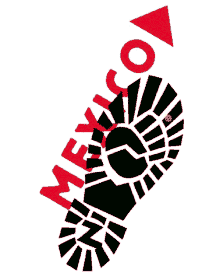 In February 2001, members of the EZLN began a march to Mexico City. The caravan included some of the oldest Zapatistas in the country who fought alongside of Emiliano Zapata at the beginning of the 20th century. Along the way they participated in the Third National Indigenous Congress with representatives of 40 of the 56 ethnic groups that live in Mexico. By the time the caravan reached Mexico City, it had grown to include several thousands of participants. [more]
In February 2001, members of the EZLN began a march to Mexico City. The caravan included some of the oldest Zapatistas in the country who fought alongside of Emiliano Zapata at the beginning of the 20th century. Along the way they participated in the Third National Indigenous Congress with representatives of 40 of the 56 ethnic groups that live in Mexico. By the time the caravan reached Mexico City, it had grown to include several thousands of participants. [more]
While representatives of the EZLN addressed the Mexican Congress, in the streets, two groups of Mexican designers, Fuera de Registro and La Corriente Electrica postered the city in solidarity.
The posters were also distributed by email with the following statement:
“The EZLN has arrived to Mexico City.
To welcome them, to support the indigenous people claims, to demand peace with justice and dignity, we have produced these images. Help us to distribute them. Use, share, print the images. We need every one’s help to demand the Mexican Government the following conditions to re-initiate the peace negotiatons with the EZLN.
- Constitutional recognition of the San Andres Agreements about Indigenous Rights and Culture.
- Freedom to all the zapatista prisoners.
- Withdrawal of the Mexican Army of the Chiapas Heights.
Mexico DF, March 2001.
Fuera de Registro, La Corriente Electrica.”
Rene Wanner has posted some images of the posters on his page, Zapata vive ! Mexican posters for peace in Chiapas.
“Fuera de Registro” is a pun which means “off register” in printing, as well as a person who can not vote because they are not registered.
Chiapas Indymedia has produced an audio documentary on ten years of Zapatismo.
Underground Networks
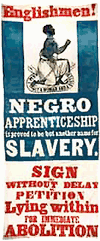 On the power of posters, pamphlets, and petitions in the time of globalization.
On the power of posters, pamphlets, and petitions in the time of globalization.
From “Sailing the Black Atlantic,” by Adam Hochschild, a review of Making the Black Atlantic. Britain and the African Diaspora, in The Times Literary Supplement, October 6, 2000:
“By requiring a complex skein of transport, trade, credit and insurance ties that connected Europe, Africa and the Americas, slavery and the slave trade were the core of the eighteenth century’s version of globalization.
In turn, one might call the black diaspora the era’s Internet. As Walvin points out, it was an information network. Word of the dramatic blossoming of abolitionism in England, for instance, was eagerly carried back across the Atlantic by black sailors, and by black domestics brought back and forth across the ocean by their West Indian masters. Slaves waiting on plantation dinner tables in Jamaica or Barbados listened hard when their owners cursed the do-gooders in Parliament, or the Quakers, who organized a huge boycott of slave-grown sugar. News from each side of the Atlantic affected the other. Reports of hundreds of abolitionist petitions flooding Parliament helped spark some of the revolts among impatient slaves in the Caribbean. The first major uprising, in the French colony of Saint Domingue (later Haiti) in the 1790s, provoked a backlash in Britain against the abolitionists, but a later one, in Jamaica in 1831-2, was crucial in hastening emancipation.”
page 19 18 17 16 15 14 13 12 11 10 9 8 7 6 5 4 3 2 1 Older »


